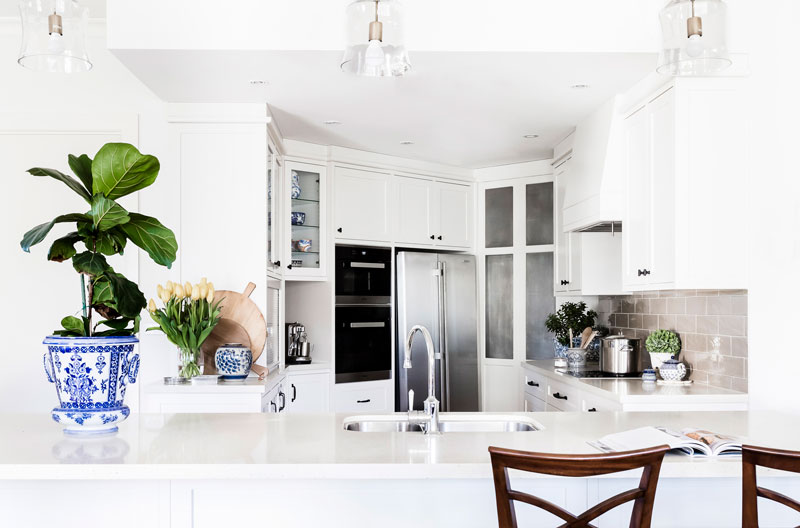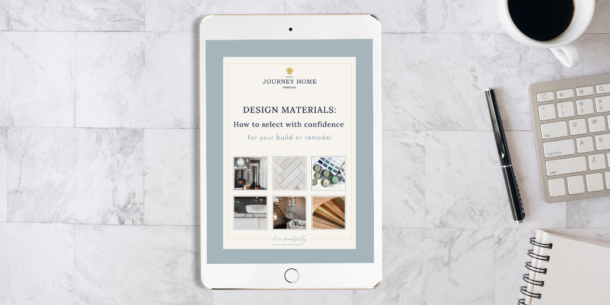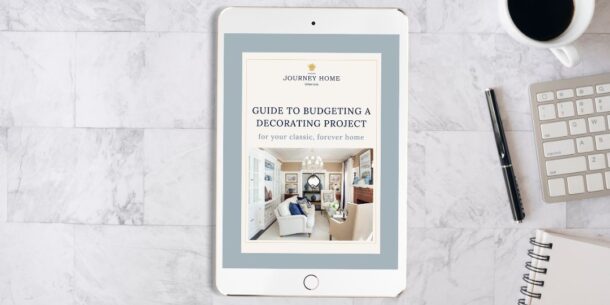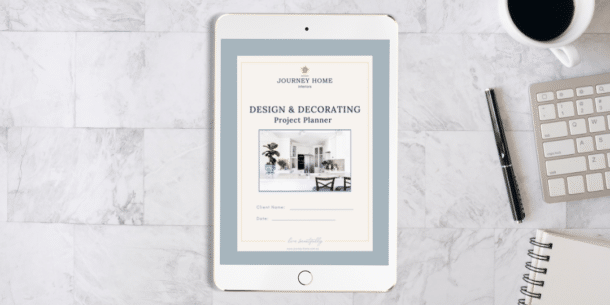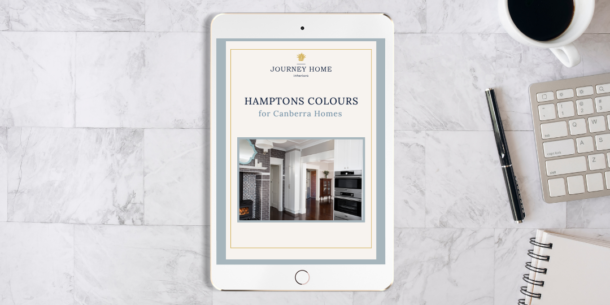Can you believe it’s March already? Summer has zipped by way too fast! Since it’s the first week of the month, we’re moving ahead to the next stop on our Plan Your Design Year Series. If you missed our other PYDY posts, there is still time to join us!
January: Look at the month-by-month design plan and commit
February: Declutter your home with conviction, plus download our free guide to decluttering with conviction!
For March, we’re going to talk about defining your project’s scope. But first… what is “scope”?
What is an interior design project’s scope?
I know I titled this blog post “strategy,” but the term your design professional will use is “scope”. Scope is essentially the full, comprehensive strategy for your design project. It includes…
- Projects Goals
- Your Budget
- Timing + Project Phases
- Defining Responsibilities
- Honing Your Aesthetic
Not a short list, is it? But trust me, every project needs (NEEDS!) to properly define ALL of these areas to be successful.
And by “successful”, I mean a project that achieves your functional and aesthetic goals, stays on budget, and wraps up in a timely manner — whether you consider “timely” lightspeed or accomplished over several years.
In other words, scope is everything!!
How can you define your project’s scope?
There are several ways to define the scope of your project. This blog post will walk you through some general guidelines to help you get well on your way, but I also want to mention that there is no substitution for a design professional in this scenario. This is simply because your interior designer or decorator can see angles of the situation that you may be too close to see.
For example, I once had a client who wanted an extension because they felt they couldn’t move in the house. But really, the problem was their selection of an enormous dining table (the size of a billiard table!) and surrounding free-standing bookcases. Replacing these with properly-scaled furniture seated the same amount of people as the dining table, opened up the space, and cost about 10% of an extension!
I had another client whose children not only each had a big, walk-in robe, but all four walls of their rooms were lined with chests of drawers and shelves. I was asked to address a lack of storage, but that really was not the issue. All it needed was a massive declutter of 50% to completely reduce the storage burden.
I’ve got days’ worth of stories like these, but the point is this:
A design professional brings an outside perspective, a wealth of experience, and for a low investment, you could end up saving yourself serious time, money, and headaches down the track.
When you’re ready for a professional to help you define your project’s scope, our Road Map Home Service is the one you want!
Until then… let’s talk about defining scope for yourself.
What are your functional goals for the space?
To define your functional goals for the space, you’ll want to spend some time thinking about how you live now and how you want to live in the future.
To do this, I usually ask clients to first make a list of what is working in their existing home and what is not working. For the “not working” side of the list, you can start brainstorming some ideas for solutions that would solve these dilemmas. (Or your designer will help you.)
For example, maybe you have been struggling with insufficient storage for years. Or, remember the old TV show Kingswood Country? If you have been moving the kingswood, to get to the commodore, to reach the motorbike, well… simply rearranging the driveway and garaging will really change your life!
I’ll pause here while you make your list…
The second aspect of functional design is the FUNCTIONAL VALUE OF BEAUTY. Read that again. Essentially, it means that if something looks drab every day, when you turn a corner or enter that space, you might not realise it, but it actually DOES affect your thoughts. And thoughts affect your life. So that’s function!
For example, maybe a shiny new kitchen that makes life enjoyable will inspire you to cook more and nourish your body. Maybe a classic, comfortable living room will inspire you to slow down and savour quiet moments. Only you can decide how you want beauty to affect you.
So, take another minute to write down some of your lifestyle goals (actions AND feelings) and any design ideas that might help bring these goals to life. Again, if you’re working with us, we’ll be sure to help you get creative!
What’s your budget?
During a Road Map Home consultation, we’ll compare your budget to your goals to see what your money might buy for you. Though we can’t give you exact quotes at this stage, we have many years’ worth of knowledge and can give you a close estimate. If there’s something you want that is outside our knowledge of pricing, I will call my trusted trades to get an idea.
If the budget doesn’t cover all your goals, then we can work down the priorities, working on what areas might be completely broken, tired, and absolutely have to be fixed, renovated or decorated.
Again, there’s really no substitute for a professional, but you can definitely get started on your own! First, you can download our Guide to Budgeting Your Home Furnishings to get a general idea of price ranges based on the rooms you’re decorating and the quality level of furnishings.
Second, you can see whether all of your goals will fit into the budgeting ranges, or you can prioritise your goals to get the most necessary updates done first. Remember, too, it’s okay to design your forever home over a longer course of time! Better to do it slowly and beautifully, than quickly and have it miss the mark.
(Another good read: 9 Tips for Completing Your Forever Home Before Retirement.)
Lastly, there are often significant costs in unavoidable repairs. These can be especially hard to stomach, as they might not make any visual or functional change to the home. For example, my husband and I recently spent $3k replacing our cracked heritage terracotta roof tiles. It looks exactly as it did before, but I guess with the recent rain we are glad we fixed that potential disaster!
If you have any essential repairs that need to be made, factor those into the budget. Handling them sooner is always better than later.
Tackle your unavoidable repairs first, like we did with these terracotta roof tiles.
What do Classic decor and furnishings really cost? Get our free expert guide!
Realistically plan for your next decorating project with our free guide to home furnishings budgeting worksheet!
What’s your desired project timeline?
In some ways, you have control over your project timeline. In others, you do not. For example, home renovation shows make the process look extremely fast, but there really is a limit to how quickly something can be done. Example… all of the tradespeople I know do sleep at night!
Assuming it’s humanly possible, the people assisting on your project will take their timeline cues from you, and the old Parkinson Law applies — the more time you give it, the more it will take.
If you have a major event coming up, such as a wedding or your much anticipated retirement, then it’s essential that we know this and plan to complete your project on time.
I also can’t help but mention how little more it costs to have help — builders, designers, and decorators can save you mountains of time and errors. A single pricey mistake from trying to DIY your project could have paid for the professional to do it right. (On that topic, check out 7 Things You Don’t Know Your Decorator Does for You!)
But what about you? How can you plan your design timeline? Well, here are some general estimates you can follow:
- For All Stages Custom Decorating for a single room: reach out to your design professional 6 months in advance
- For All Stages Custom Decorating for a whole home: reach out 9 months in advance, more for really large homes
- If you’re beginning with Stage 1 or Stage 2 of our 4 Stage Signature Decorating Service: start at least 4-6 months in advance of when you want Stage 4 to be complete. (Products can sometimes take 1-2 months to deliver.)
- If you’re beginning with Stage 3 or Stage 4 of our 4 Stage Signature Decorating Service: start at least 2-3 months in advance of when you want Stage 4 to be complete.
- If you don’t know where to start, book our Road Map Home service well in advance of when you want your forever home ready to live in!
What’s your ideal design aesthetic?
Setting out your aesthetic wish at the beginning of the project will help you determine WHO the right people are to bring it to life. Maybe you’ve been following our Plan Your Design Year series and love our advice and process, but you don’t love classic design. That’s okay, we’re happy to share our wisdom and encourage you to find the design professional whose aesthetic best matches your own.
A great way to discover your design aesthetic is to make Pinterest boards, or browse the portfolios of designers and decorators in your area. Of course, your forever home shouldn’t be a copy of these spaces, but take note of what aspects of the design feel most like home to you. Then share these discoveries with your designer.
If you book any of our design services, we’ll send you a step-by-step guide to creating Vision Boards for your projects… It’s the fun part!
Well, this post certainly got long, but that’s the point of scope — defining and strategizing every aspect of your design project so that when your forever home comes to life, it’s as classic, comfortable, and beautiful as you always imagined.
And lucky for you, the month of March has 5 weeks! So that’s plenty of time for you to go through each step of this scope-defining process and get yourself ready for April’s adventure: Design Concept Dreaming.
So I hope you’ll download our Guide to Budgeting Your Home Furnishings, tackle the above tasks, and start dreaming big and beautifully!
Yours,
Nadine

